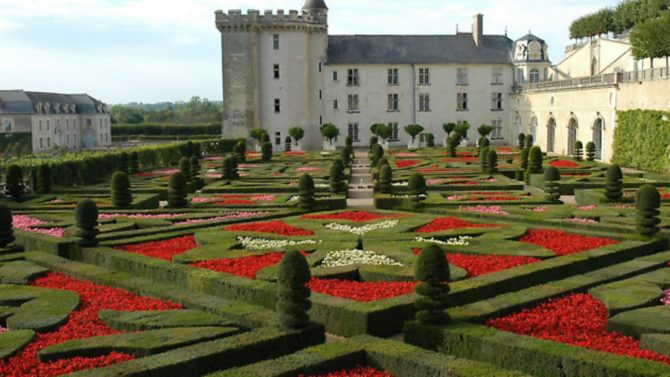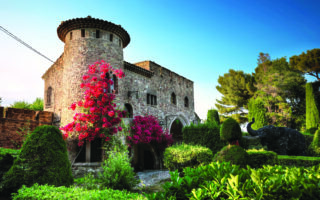4 Loire châteaux lookalikes

Following the trail of four of the Loire Valley’s best-loved châteaux, Rachel Johnston proves you don’t need royal wealth to acquire their majestic attributes

1. Le Château de Chambord Notable features: Tuffeau stone, spiral staircase, parkland, water
Sharing its name with a famous raspberry liqueur produced nearby, the town of Chambord in Loir-et-Cher, 15km east of Blois, is almost more synonymous with its château, the largest in the Loire Valley. The fact that this staggeringly vast, palatial structure was built by the king in 1519 simply as a weekend hunting lodge is just one of its jaw-dropping details. A UNESCO World Heritage Site since 1981 and surrounded by a moat and a 5,440-hectare domaine, it is constructed from the local tuffeau stone, a marine sedimentary rock that gives off a magical pearly irridescence in the sunlight and gives the castles of Disney films a run for their money. One of Chambord’s architectural highlights is the spectacular double helix staircase at its heart, designed by Leonardo da Vinci supposedly to prevent the king’s wife and mistress ever running into each other.


Chambord might be a hard act to follow when it comes to househunting but, ticking the boxes for all four of its notable features, this early 19th-century château is an exciting opportunity at €950,000. It may not quite match Chambord’s 440 rooms but with 900m2 of living space, it’s no modest retreat, and a period spiral staircase sweeps up from the entrance hall to five bedrooms. Built from solid tuffeau blocks, the stone is still in excellent condition despite its fragility and proneness to weathering. The property is surrounded by an enclosed four-hectare park which includes a section of river frontage and an island on which the famous French poet, Pierre de Ronsard, used to write many centuries ago – and, as Francis I was a keen patron of the arts and counted poetry among his passions, this is an appropriate extra piece of the kingly jigsaw puzzle. The château is around 50km from its idol Chambord and just 20 minutes’ drive from the TGV station at Vendôme, with regular trains to Paris. There is a good choice of local market towns and the nearby village offers all amenities. Some refreshing of the property is needed but the current owner has already completed an extensive renovation with new electrics, plumbing and heating. prestigeproperty.co.uk
2. Le Château de Blois Notable features: Tripartite form, internal courtyard, central town location

Capital of Loir-et-Cher and gateway to the old region of Sologne, Blois was built on a pair of steep hills and is a bustling maze of twisting medieval streets and animated squares with a population of around 50,000. The town has a growing reputation for its university and higher education, and numerous modern cultural events and activities ensure it hasn’t remained stuck in the era of Francis I, despite being awash with history. The town’s château was the first construction undertaken by the king and, in 1845, the first historical residence to be restored, acting as a model for the restoration of many others. One of its most unusual features is the juxtaposition of three contrasting architectural styles – set impressively around a cobbled courtyard are Gothic, Renaissance and Classical wings, the Renaissance wing named after Francis and bolstered by an open staircase affording views of the valley.

With many châteaux isolated from civilisation by their expanse of surrounding parkland, finding one situated in the centre of a village despite its 21 hectares is something of a rarity. But on the market for €996,000, this château is situated west of Blois in a pretty village of 1,000 inhabitants. Elegant gates lead from the end of a tree-lined drive into an internal courtyard, with more than enough turning space for a horse-drawn carriage or three. Mirroring Blois’ tripartite form, the property comprises three separate buildings: the main 17th/18th-century residence, a pavilion built in 1950 and a caretaker’s house in need of restoration, each with an architecturally different facade. With its 25m swimming pool, adjacent tennis court and a total of 46 bedrooms, this property would make an ideal hotel. sifex.co.uk
3. Le Château d’Amboise Notable features: Elevated views, turrets, chapel

Poised on a spur of land high above the River Loire’s serene waters with near-matchless panoramic views, this château is the quintessential kingly residence and was allegedly Francis’ favourite – in fact, the king spent his childhood here when it belonged to his mother, Louise of Savoy. Flags fly proudly from its ramparts and sharply pointed, slate-clad turrets glint in the sun. The accompanying Chapel of St-Hubert is, much to many visitors’ surprise, the final resting place of Leonardo da Vinci, who lived and worked at nearby Clos-Lucé. Like its counterpart in Blois 35km upriver, the château has an urban setting – but it appears to float above the roofs of Amboise rather than sit among them. It’s quite a hike up from the pretty boutiques and delicatessens of pedestrianised Rue Nationale to reach this majestic vantage point, even with a religieuse from renowned pâtisserie Maison Bigot inside you.

Unlike the other three broadly set châteaux, Amboise has a tight, compact architectural form and this example on the market caught my eye when making comparisons. With an asking price of €950,000, it shares Amboise’s elevated setting and enjoys fabulous views of walled parkland from its balustraded terrace. Every imaginable kingly activity has been provided for here, too, from banqueting to billiards to taking a dip. prestigeproperty.co.uk
4. Le Château de Villandry Notable feature: Formal gardens

Nowhere is the Loire Valley’s label as the ‘Garden of France’ more stunningly brought to life than at Villandry. Featured in programmes and countless books as a true icon of formal French horticulture and dubbed “one of the great gardens of the world” by Monty Don, the château’s garden was created in 1906 by owner Joachim Carvallo. This may be relatively recent compared with the château’s 16th-century origins, but it was nonetheless designed around the notion of how it probably looked in its Renaissance heyday. There are no less than seven separate areas within the garden, each one telling a story and evoking a different mood: a classically inspired water garden with pond and a cloister of lime trees; an ornamental garden with planting corresponding to different kinds of love; a playful hornbeam maze. By far the largest of the areas is the potager or kitchen garden, stuffed with a staggering 80,000 vegetable plants every year that are, surprisingly, intended more as decoration to impress than as crops to be harvested. Everything at Villandry is tightly marshalled and regimented – box hedging is clipped to perfection and gravel paths are flawlessly raked – and the whole garden is best appreciated from one of the château’s towers, from which current owner Henri Carvallo can survey his estate with what must be immense satisfaction.
If it’s the grandeur of a formal garden that’s on your must-have list, try this 14-bedroom property in Loir-et-Cher on for size, listed as a monument historique. Blowing the £1m budget at €5,500,000 and admittedly a bit of a wildcard, it simply had to be included for its magnificent garden designed by André Le Nôtre, principal gardener to Louis XIV who was also responsible for the garden at the Palace of Versailles. The garden was realised in 1755 by Jean-Marie Morel and comprises immaculate ranks of box and yew trees plus a magnificent 80m stone bassin with fountains not unlike that in Villandry’s water garden, as well as its own enclosed potager and orchard. The parkland is stippled with groups of oak and cedar trees and there are wonderful perspective views in all directions. It’s not only in its outside space that this château resembles Villandry; there are plenty of architectural similarities too, including the high slate roofs and elaborate dormer windows, and the accompanying pavilions recall the coach house in Villandry’s grounds. You may need to enlist a hardy team of gardeners to help here, but boy would it be worth it. sifex.co.uk

Share to: Facebook Twitter LinkedIn Email


